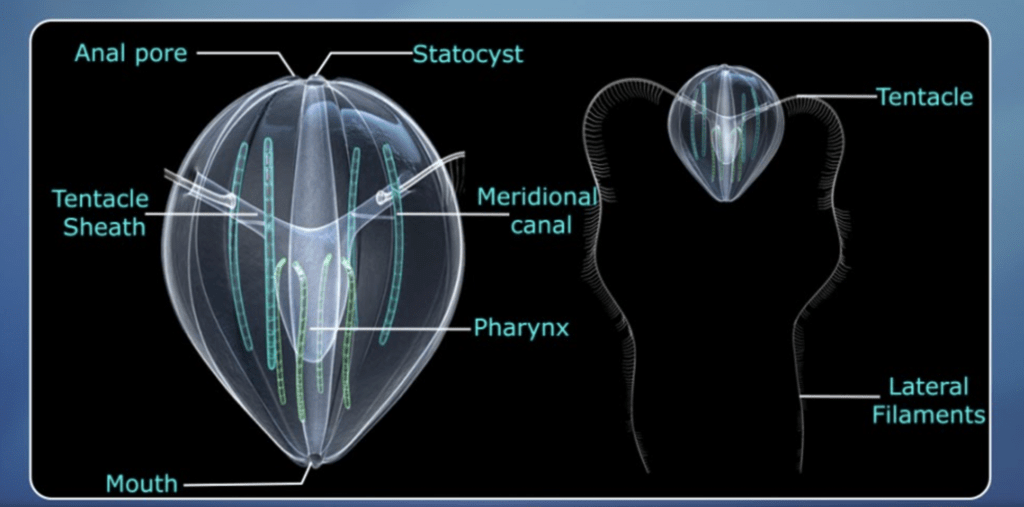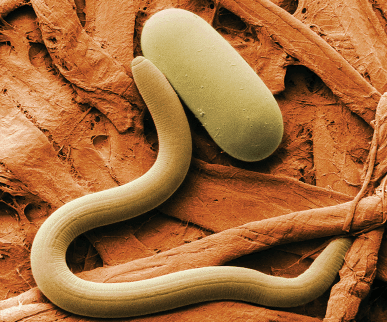Phylum - Ctenophora | Biology for JAMB PDF Download
Ctenophora Definition
Ctenophores are free-swimming, transparent, jelly-like, soft-bodied, marine animals having biradial symmetry, comb-like ciliary plates for locomotion, the lasso cells but nematocytes are wanting. They are also known as sea walnuts or comb jellies.
Phylum Ctenophora Characteristics
- They are free-swimming, marine, solitary, pelagic animals. No polymorphism and no attached stages were found.
- The body is transparent, gelatinous, pear-shaped, cylindrical, or flat or ribbon-shaped.
- They have a biradially symmetrical body along an oral-aboral axis.
- They have an external surface with comb-like 8 ciliary plates for locomotion. Hence name as comb jellies.
- They have a pair of long, solid, retractile tentacles.
- Their body organization is cell- tissue grade.
- Their body is acoelomate and triploblastic, with the outer epidermis, inner gastrodermis, middle jelly-like mesoglea with scattered cells, and muscle fibers.
- Their digestive system contains the mouth, stomodaeum, complex gastrovascular canals, and 2 aboral anal pores.
- They lack nematocysts.
- They have special adhesive and sensory cell i.e. colloblasts or lasso cells present in tentacles which helps in food captures.
- They lack skeletal, circulatory, respiratory, and excretory organs.
- Their nervous system is diffused types and the aboral end bears a sensory organ, called statocyst.
- They are monoecious (hermaphrodite); gonads are endodermal situated on walls of digestive canals.
- Their development direct with characteristic cydippid larva.
- They lack asexual reproduction and alternation of generation.
- Regeneration and paedogenesis are common in them.

Phylum - Aschelminthes (Nematoda)
The organisms belonging to the phylum Nematoda are also known as “roundworms”.
- There are 28000 species of Nematoda identified till date. They are unsegmented vermiform animals. The epidermis has dorsal and ventral nerve cords.
- The Nematodes present in the soil feed on the bacteria, fungi, and other nematodes, and play an important role in nutrient recycling. They also attack the insects and control the pests. However, they cause severe damage to plants. They feed on the plant roots and reduce the nutrient uptake and stress tolerance of the plant.
 Nematoda
Nematoda
- A spadeful of soil contains numerous Nematodes. They cause diseases such as Ascariasis, Trichuriasis, Hookworm, Enterobiasis, Filariasis, and Angiostrongyliasis in humans.
Characteristics of Nematoda
- Grobben gave the name = Aschelminthes
- Gagenbaur named it as as Phylum Nemathelminthes. The phylum includes roundworms.
- Aquatic, terrestrial, free-living or parasites.
- Animals of this phylum are Cylindrical, tapering at both ends without segmentation.
- Bilaterally Symmetrical - Triploblastic, Organ-system level and having tube within tube plan.
- The anterior end does not show a distinct head.
- No appendage.
- Body wall consists of:
Cuticle - Firm, non-living, resistant to digestive enzymes of the host.
Moult (changed) many times during the growth period (usually four times).
Epidermis - Syncytial - Muscle layer - Longitudinal fibres divided into four quadrants. (each with 150 muscle cells)
- Body cavity is Pseudocoel (developed from blastocoel) and contains Pseudocoelomic fluid.
- High fluid pressure in the pseudocoelom maintains body shape. It is called Hydroskeleton.
- Digestive tract is complete and differentiated into mouth, pharynx, intestine & Anus.
The mouth is surrounded by 3 - lips having sensory papillae and amphids. The pharynx is muscular. It is used to suck food. The intestine is non-muscular. - Respiration is through the body surface by diffusion.
- The circulatory system is undeveloped
- Nervous system comprises of circum pharyngeal ring (Brain).
- Sense organs like Papillae (Tangoreceptors), Amphids (chemoreceptor) are present on the lip.
Paired unicellular Phasmids (chemoreceptor) are found near the hind end of the body. - Excretory system is H-shaped formed by single cell called Renette cell.
The excretory substance is ammonia. - The reproductive system is developed and the sexes are generally separate.
- Sexual dimorphism is present.
- Male is smaller than female and curved from its caudal end.
- Male has pineal spicule for copulation. The genital tract joins the digestive tract to form the cloaca.
- Female is larger than male and straight. Genital tract opens independently. Female lays numerous eggs with Chitinous shells.
- Fertilization is internal and development is mostly direct.
- Cleavage is a Holoblsatic spiral and determinate type.
- Number of cells are fixed from larva to adult such development is known as Eutely.
Additional Information
Classification of Nematoda
On the basis of caudal receptors or phasmids, Aschelminthes can be divided into 2 classes-
Class–Aphasmidia
- Members of this class lack phasmid.
- Many types of amphids are found.
- One pair of excretory canal are present.
- Caudal adhesive glands are found.
Ex. - Enoplus, Desmoscolex, Trilobus, Lapillaria
Class–Phasmidia
- Phasmid is present.
- Caudal adhesive glands are not found.
Ex – Ascaris*
- It is a parasite of the small intestine.
- It is also called roundworm.
- Rhabditiform larva exists in the life cycle of Ascaris.
- Ascaris leads to a disease called Ascariasis.
- Infective stage of Ascaris to man is embryonated egg with 2nd stage juvenile.
- Trichinella spiralis (Trichinia worm) occurs in voluntary muscles, causes trichinosis.
Ex– Trichuris trichiura
- It is also called whipworm.
- It is a parasite of the large intestine of man.
- No larval stage in the life cycle.
- It leads to anaemia and Diarrhoea.
Ex-Enterobius
- It is also called pinworm or seatworm.
- It is a parasite of the human intestine.
- It causes enterobiasis.
- No intermediate host.
Ex-Ancyclostoma
- Cause - Ancyclostomiasis.
- It is also called hookworm.
- Its larva penetrates through the sole of the person.
- Live in the intestine and suck tissue fluid.
Ex-Wuchereria
- It is also filaria worm.
- Its life cycle gets completed in two hosts. Man is the primary host, while female culex/Aedes mosquito is the secondary host.
- It leads to a disease called Elephantiasis.
- Adult worm blocks lymph duct which leads to swelling of limbs.
- Females are ovoviviparous. Female lays juvenile microfilaria.
- Infective stage to man is microfilariae.
Ex- Dracunculus
- They are also called Guinea worms and also referred to as “fiery serpent”.
- They are digenetic, man is the primary host while water flea (Cyclops) is the secondary host.
- Completely eradicated from India (eye worm)
Ex- Loa-loa (eye worm)
- Found in subdermal connective tissues. Sometimes they pass across eyeball.
- Tabanas fly act as vector.
Additional Information
Phylum Ctenophora Classification
Phylum Ctenophora contains about 100 know species and grouped in 2 classes
Class 1. Tentaculata
- Adults with 2 long aboral tentacles.
- In some larva has tentacles, while adults have oral lobes.
- Mouth narrow and pharynx small.
➤ Order 1. Cydippida
- Body simple, round, and oval.
- Digestive canals terminate blindly; no anal pores.
- Tentacles are two long and branched.
- Tentacles are retractile into pouches or sheath.
- Examples: Mertensia, Pleurobrachia, Hormiphora
➤ Order 2. Lobata
- Body oval, laterally compressed.
- Adults with 2 large oral lobes and 4 slender flap-like auricles around the mouth.
- Pouched or sheath tentacles in the larva.
- Tentacles reduced and without sheath in adults.
- Gastrovascular canals are connected by a ring at oral ends.
- Examples: Mnemiopsis, Bolinopsis
➤ Order 3. Cestida
- Body elongated compressed/flat, ribbon-like.
- Two main tentacles in the sheath but reduced.
- Many small lateral tentacles along the oral edge.
- Combs plates in 4 rows but rudimentary.
- Examples: Cestum, Velamen
➤ Order 4. Platyctenea
- Body greatly compressed/flat in the oral-aboral axis.
- 2 well- developed tentacles with sheath.
- Comb plates reduced in adults.
- Adapted for creeping.
- Examples: Ctenoplana, Coeloplana
➤ Order 5. Thalassocalycida
- They are found surface waters down up to 2,765 Ms in Atlantic oceans and the Mediterranean Sea.
- The body is a bell of Medusa shaped and may be up to 15 cm in diameter.
- Mouth slit holds by a central cone-shaped peduncle.
- A pair of small tentacles hang from the side of the peduncle.
- Com jelly is with its transparent and colorless body. Usually different to see.
- They hold the bell wide opens to captures prey i.e. Zooplankton.
- Presumably hermaphroditic.
- This species has limited swimming ability compared to other comb jellies.
- Examples: Thalassocalyce inconstans.
Class 2. Nudu
- Body large, conical, and compressed laterally.
- Without tentacles and oral lobes.
- Wide mouth and large pharynx.
- Voracious feeder.
➤ Order 1. Beroida
- No tentacles and oral lobes.
- Body large, conical, and laterally compressed.
- Mouth large.
- Voluminous Stomach.
- Examples: Beroe
|
221 videos|172 docs|126 tests
|
FAQs on Phylum - Ctenophora - Biology for JAMB
| 1. What is the definition of Ctenophora? |  |
| 2. What are some key characteristics of Ctenophora? |  |
| 3. What is the phylum classification of Ctenophora? |  |
| 4. How do Ctenophores move? |  |
| 5. What is the ecological role of Ctenophores? |  |





















